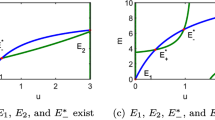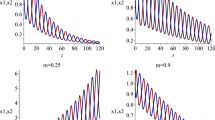Abstract
Considering a collection of agents representing the vertices of a graph endowed with integer points, we study the asymptotic dynamics of the rate of the increase of their points according to a very simple rule: we randomly pick an an edge from the graph which unambiguously defines two agents we give a point the the agent with larger point with probability p and to the lagger with probability q such that \(p+q=1\). The model we present is the most general version of the nearest-neighbour competition model introduced by Ben-Naim, Vazquez and Redner. We show that the model combines aspects of hyperbolic partial differential equations—as that of a conservation law—graph colouring and hyperplane arrangements. We discuss the properties of the model for general graphs but we confine in depth study to d-dimensional tori. We present a detailed study for the ring graph, which includes a chemical potential approximation to calculate all its statistics that gives rather accurate results. The two-dimensional torus, not studied in depth as the ring, is shown to possess critical behaviour in that the asymptotic speeds arrange themselves in two-coloured islands separated by borders of three other colours and the size of the islands obey power law distribution. We also show that in the large d limit the d-dimensional torus shows inverse sine law for the distribution of asymptotic speeds.










Similar content being viewed by others
Notes
For instance, this is not true for the total amount of natural gold on planet Earth.
Yet one can possibly think of chemical limitations of a given environment.
See for instance [15].
Except for the case \(q=1/2\) when it is identically satisfied.
One could, in this case, split the water evenly to both buckets. However giving points to ties do not change the general structure of the model.
A humourous person would write Eq. 31 as \(\vec {v}=\vec {v}(\vec {v})\).
As an example let us consider the model on the complete graph as in [1]. There it is seen that if the maximal theoretical asymptotic speed -which would only be attained if the same agent is chosen at every pick and it always wins- is normalized to unity the possible actual speeds of the agents -in statistical terms- range between q and p, for \(p{\>}q\). Which shows that characteristics diverge faster as one approaches \(p=1\). This is however clearly a generic situation as shown by our analysis leading to Eq. 31.
See for instance [17] for a general introductory book.
Lecture notes on hyperplane arrangements by Stanley in [17].
If the orientation can be cyclic it can not be associated with an ordering of points for those agents residing on nodes of the cycle in question, they will have equal points in a cyclic orientation.
Remember that we have already shown that when two connected agents i and j have the same speed, that is \(v_{i}=v_{j}\), the velocity field is parallel to the hyperplane \(x_{i}=x_{j}\).
For instance see [19] and references therein.
See also [16].
References
Ben-Naim, E., Vazquez, F., Redner, S.: On the structure of competitive societies. Eur. Phys. J. B 49(4), 531–538 (2006)
Ben-Naim, E., Redner, S., Vazquez, F.: Scaling in tournaments. Europhys. Lett. 77(3), 30005 (2007)
Ben-Naim, E., Vazquez, F., Redner, S.: What is the most competitive sport. J. Korean Phys. Soc. Part 1 50(1), 124–126 (2007)
Ben-Naim, E., Hengartner, N.W.: How to choose a champion. Phys. Rev. E Part 2 76(2), 026106 (2007)
Carbone, A., Kaniadakis, G., Scarfone, A.M.: Tails and ties. Eur. Phys. J. B 57(2), 121–125 (2007)
Fujie, R., Odagaki, T.: Self organization of social hierarchy and clusters in a challenging society with free random walks. Physica A 389(7), 1471–1479 (2010)
Ben-Naim, E., Hengartner, N.W., Redner, S., Vazquez, F.: Randomness in competitions. J. Stat. Phys. 151(3–4), 458–474 (2013)
Okubo, T., Odagaki, T.: Mean field analysis of phase transitions in the emergence of hierarchical society. Phys. Rev. E. Part 2 76(3), 036105 (2007)
Peixoto, T.P., Bornholdt, S.: No need for conspiracy: self organised cartel formation in a modified trust game. Phys. Rev. Lett. 108(21), 218702 (2012)
Ben-Naim, E., Vazquez, F., Redner, S.: Parity and predictability of competitions. J. Quant. Anal. Sports 2(4), 1 (2006)
Ben-Naim E., Kahng B., Kim J. S.: Dynamics of multiplayer games. J. Stat. Mech. P07001 (2006)
Mungan, M., Rador, T.: Dynamics of three agent games. J. Phys. A 41, 055002 (2008)
Derici, R., Rador, T.: Merger dynamics in three agent games. Eur. Phys. J. B 83, 289–299 (2011)
Derici, R.: Merger dynamics in three agent games, M.S. Thesis Graduate Program in Computational Science and Engineering, Bog̃aziçi University (2009)
Baxter, R.J.: Exactly Solved Models in Statistical Mechanics. Academic Press, London (1982)
Lax, P.D.: Hyperbolic Partial Differential Equations. Courant Lecture Notes 14, ISBN-13: 978-0-8218-3576-0
Miller, E., Reiner, V., Sturmfels, B. (eds.): Geometric Combinatorics. IAS/Park City Mathematics Series (2007)
Orlik, P., Terao, H.: Arrangement of Hyperplanes. Springer, New York (1991)
Redner, S.: A Guide to First Passage Probabilities. Cambridge University Press, Cambridge (2001)
Brown, K.S., Diaconis, P.: Random walks and hyperplane arrangements. Ann. Probab. 26(4), 1813–1854 (1998)
Rankine, W.J.M.: On the thermodynamic theory of waves of finite longitudinal disturbances. Philos. Trans. R. Soc. Lond. 160, 277288 (1870)
Hugoniot, H.: Méemoire sur la propagation des mouvements dans les corps et spécialement dans les gaz parfaits (première partie) [Memoir on the propagation of movements in bodies, especially perfect gases (first part). J. l’École Polytech. 57, 397 (1887) (in French)
Hugoniot, H.: Mémoire sur la propagation des mouvements dans les corps et spécialement dans les gaz parfaits (deuxième partie) [Memoir on the propagation of movements in bodies, especially perfect gases (second part)]. J. l’École Polytech. 58, 1–125 (1889) (in French)
Krapivsky, P.L., Redner, S., Ben-Naim, E.: A Kinetic View of Statistical Physics. Cambridge University Press, Cambridge (2010)
Flory, P.J.: Intramolecular reaction between neighboring substituents of vinyl polymers. J. Am. Chem. Soc 61, 1518 (1939)
Author information
Authors and Affiliations
Corresponding author
Appendix: The Chemical Potential Approach for the Ring Graph
Appendix: The Chemical Potential Approach for the Ring Graph
In this appendix we shall develop an approximation for the statistics of our model on the ring graph. We shall assume that all configurations with the same number of M-type agents are equally probable. But we shall weigh them with respect to the full LS checkerboard configuration via a chemical potential \(\mu \). For instance if a configuration contains k many M-type agents we shall weigh it with \(\mu ^{k}\).
As well known, to obtain the statistics of the ring diagram one will need to solve the path diagram first. But since we shall ultimately be considering the limit of infinite number of vertices we do not really need to solve for the ring diagram’s partition function: Using a well known trick, whenever we need to calculate the expectation value of a given finite size subconfiguration we can place it in the middle of an infinitely long path diagram.
Now let us remember that the configurations we are interested in are all 3-colourings where the colours are labelled as L, S and M respectively and where tiles of type LML and SMS are forbidden.
We therefore have the following partition function for the path graph
where the measure \(\mathcal {Q}\) is given as
Summing over the first agent we get the following recursion relation
where
and thus \(M_{N}\) is the probability that the first agent on the path has colour M. Summing over the first agent we get the following recursion relation
Let us also define the following, since we shall eventually need them
and thus \(L_{N}\) and \(S_{N}\) are the probabilities that the first agent has colour L and S respectively. Since these are exclusive we of course have \(M_{N}+L_{N}+S_{N}=1\).
One can, summing the first agent out, show that \(L_{N}\) and \(S_{N}\) obey the following
One can by direct enumeration show that the initial conditions for \(L_{N}\) and \(S_{N}\) are identical and thus we must have \(L_{N}=S_{N}\) which means that they are equal to \((1-M_{N})/2\). This is expected since the constraints in the measure are symmetric under \(L\leftrightarrow S\).
Now one can, by rearranging the equations involving \(Z_{N}\) and \(M_{N}\), show that they are equivalent to
To resolve Eq. A.8 we need to provide two initial conditions. But these initial conditions must be such that they cover all the relevant constraints and thus \(Z_{3}\) must be in the list. With these we get the following solution
with
Note that \(\vert \lambda _{+} \vert >\vert \lambda _{-}\vert \) and hence we have
1.1 Mean Number of M-Type Agents
To get the average number of M-type agents we consider the probability that the agent in the middle of a path graph is of type M. This means we need to calculate,
By summing over the agent \(\sigma _{0}\) we shall end up with
In the limit \(N\rightarrow \infty \) the quantity \(\bar{M}_{2N+1}\) must converge to \(n_{M}\) of the paper and we recover
as advertized before via other means.
1.2 The Distance Distribution Between Two M-Type Agents
To study the probability distribution P(k) of distances between two M-type agents we again place the region of interest in the middle of a path graph of length \(2N+k+2\) with \(k\ge 1\). A straightforward calculation yields
which in the large N limit will give us
As expected and advertized in the paper via other means this probability distribution adds up to \(n_{M}\)
Furthermore again as advertized in the paper via other means we see that \(\lambda _{+}=e^{\alpha }\) with \(\alpha =\ln (2n_{L}/(4n_{L}-1))\).
1.3 The Pair Correlation Function of Asymptotic Speeds
The quantity of interest is
But due to the flip symmetry the middle two terms are equal and thus we have
Furthermore since \(L_{i+k+1}+M_{i+k+1}+S_{i+k+1}=1\) we can recast this as
Some tedious algebra will yield the following equations
The quantity \(B_{LL}(k)\) is the probability that a path graph starts with an L-type agent and ends with an L-type agent. Similarly the quantity \(B_{LS}\) is the probability that a path graph starts with an L-type agent and ends with an S-type agent. They both satisfy the following equation
where \(f_{k}\) stands either for \(B_{LS}(k)Z(k)\) or for \(B_{LL}(k)Z(k)\).
However as one can easily show that their initial conditions, which one can explicitly find by direct enumeration of graphs starting with \(k=2\), are not the same. Therefor they are not equal, and in fact there is no a priori expectation for them to be equal anyways.
One can readily find the particular solution to be \(f^{P}_{k}=Z_{k}/2\). Therefor the general solution can be cast as \(f_{k}=f^{P}_{k}+g_{k}\) where \(g_{k}\) obeys
which can be readily solved to give
where one has
Note that \(\vert \lambda _{+}\vert > \vert \tilde{\lambda }_{\pm }\vert \). All one now needs are the initial conditions and we have \(B_{LL}(2)=0\) and \(B_{LL}(3)=1/Z_{3}\) along with \(B_{LS}(2)=1/Z_{2}\) and \(B_{LS}(3)=\mu /Z_{3}\).
With these and taking the \(N\rightarrow \infty \) limit we finally have
with
We have thus achieved an exact expression for the pair correlation functions in the limit \(N\rightarrow \infty \). One can furthermore show that as \(k\rightarrow \infty \) one has \(C_{k}\rightarrow 1\). This expected since \(\langle z_{i}z_{i+k}\rangle \) is expected to factorize as \(\langle z_{i}\rangle \langle z_{i+k}\rangle \) and \(\langle z_{i}\rangle =1\) via the constraints on the system.
Rights and permissions
About this article
Cite this article
Rador, T. Dynamics of Nearest-Neighbour Competitions on Graphs. J Stat Phys 169, 265–302 (2017). https://doi.org/10.1007/s10955-017-1870-3
Received:
Accepted:
Published:
Issue Date:
DOI: https://doi.org/10.1007/s10955-017-1870-3




